|
|
Review of Samsung Z710 3.2 Mpix camera
Samsung has demonstrated various handsets, armed with high resolution
cameras numerous times, though not a one out of them made it to
the European market. And one of the first mass products in this
very line-up is Samsung Z710, equipper with a 3.2 Mpix camera module,
powered by CCD matrix. The majority of competitors apply CMOS solutions,
as while the quality is nearly the same, energy consumption proves
to be less. The history of GSM handsets mentions only a few models,
featuring CCD module Ц one of this is Sony Ericsson S700. In fact,
the core principles of the modelsТ design are the same: the back
part, holding a camera module, is alike a digital camera; there
is a possibility for getting a grip on the phone with two hands;
the objective glass is covered by a shutter, with a flash located
nearby.



Model Samsung Z710 is a clamshell with rotary exterior part Ц once
youТve opened the device and turned one of the halves, the handset
obtains highest possible resemblance to a digital camera. Camera
mode is switched on simultaneously with the abovementioned manipulations.
In order to start shooting, you have to open the shutter, though
itТs not an easy task since the latch is rather tight and small
in size. If you get a closer look at it, youТll discover that the
shutter, covering the camera is not well-adjusted Ц as a matter
of fact, the root of the problem lies in handsetТs exploitation,
since usually the shutter gets this outlook after a month or two.
However it doesnТt cause any inconveniences, in light of the fact
the shutter preserves the objective glass from being touched rather
than from dust, although itТs a part of its functionality as well.


The physical specifications of the object-glass are as follows:
f=3.48 мм, 1:3.0, auto-focus.
When in the shooting mode, the upper part of the device hold three
buttons: a double key, allowing user to zoom image, a red button
for switching between various modes and finally the last one performs
shooting. I shall note that one can readily take pictures even when
the screen is just open (not rotated), and in closed condition.
Though you will find it easy to set up the camera in open condition,
as here you will only need to choose all the required settings from
the menu or simply use the keypad. Besides, the handset provides
shortcuts, assigned to numeric keys, which let you change picture
size, shooting mode etc. in one touch.
Nevertheless, the developers also have made sure that you can operate
the camera even when the device is closed Ц on default the screen
shows a status bar, featuring icons of all chosen modes, on the
right you will find actions, bound up with the side keys. Having
pressed the red button, you will call up the settings mode, horizontal
displacement is performed by pressing the double key. In order to
adjust the settings, first of all you need to press the red button
one more time, then pick the required item, scroll the list with
the help of double key and accept the choice by pushing the red
key again, the next step is to return back to a higher menu level
Ц this is done via the shooting key. Even though this process appears
to be very complicated at the fist glance, itТs easily gotten used
to. To name the advantages, I shall say that the device saves the
last changed parameter and when entering the menu repeatedly, you
will see exactly this item. On the other hand I doubt many will
use these advanced settings and will prefer using auto mode to this.
The best way to adjust the camera is to do it in the standard open
condition.


LetТs peek in the list of main settings and find out how they affect
the quality and other parameters.
Shot mode Цsingle shot, multi shotЦ 6, 9, 12 and
15 images respectively, mosaic shot. The last mode allows choosing
from the following types: 2х2, 3х3.
Size Ц the top resolution, provided in the handset
is 2048х1536 which is equal to 3.15 Mpix. There are also smaller
sizes available, e.g 1600х1200, 1280х960, 1024х768, 800х600, 640х480,
320х240, 240х320 pixels. When using the best resolution, a single
image can be from 0.7 to 1.1 Mb in size, depending on richness of
a picture in details. The pictures, taken in lower resolutions,
take up much less storage respectively.

Macro modeЦ this mode can be e turned off or on.
Effective distance while shooting in this mode is about 7-8 centimeters.
Flash Ц can be switched off, work either in auto-mode
or be permanently on, or used in shooting only mode. The flash itself
is rather poor and can make much difference only when shooting in
really dark places, though not at night or absolute darkness. ThatТs
why the flash is effective only at dusk, as itТs a common LED.

Timer Ц using this function, one can take picture
with the delay of 3, 5 and 10 seconds.

Effects Ц the set of the special effects is rather
common: Black&White, Negative, Sepia, Emboss, Sketch. Their
quality doesnТt leave any negative impressions as well.

Effects
|
 |
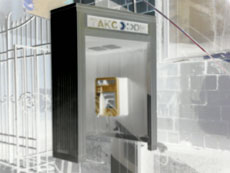 |
(+)
увеличить, 2048x1536, JPEG |
(+)
увеличить, 2048x1536, JPEG |
 |
 |
(+)
увеличить, 2048x1536, JPEG |
(+)
увеличить, 2048x1536, JPEG |
 |
|
(+)
увеличить, 2048x1536, JPEG |
|
Frames Ц various frames may be applied to pictures
Ц there are 50 of them, so even the most enthusiastic congratulators
will be satisfied. While working with the frames, the resolution
is set to 320x240 pixels automatically.

White balance Ц Automatic (default), Horizon,
Alight, Tungsten, Fluorescent, Daylight, Cloudy, Shade. When using
the auto-mode, the device isnТt always capable of measuring the
illumination and setting appropriate parameters. Typical examples
of this weakness are situations, when you are shooting objects on
the floor Ц in this very case, you better use manual mode.

ISO. On default sensitivity is set to Auto, though
youТre at liberty to choose the value yourselfЦ 50, 100, 200, 400.
But you should consider leaving Auto mode as it as, since youТll
see particles in any case.

ISO
|
| 50 |
100 |
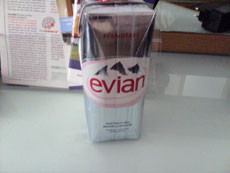 |
 |
(+)
увеличить, 2048x1536, JPEG |
(+)
увеличить, 2048x1536, JPEG |
| 200 |
400 |
 |
 |
(+)
увеличить, 2048x1536, JPEG |
(+)
увеличить, 2048x1536, JPEG |
| Auto |
|
 |
|
(+)
увеличить, 2048x1536, JPEG |
|
Exposure value Ц the exposure time may vary from
-6 to +6 Ц this is a tricky parameter, as big exposure values require
cameraТs stability, what is nearly impossible, when holding the
camera in hands. Shakings of the camera cause the majority of problems
here, because the device doesnТt always have time to take a sharp
and clear picture. In order to obviate these difficulties, you will
need to stand motionless for 1-2 seconds after triggering the shutter
button.
ViewFinder Ц the display can only offer you a
Full Screen picture, Full Screen and Guide picture or Full Screen
and Indicators picture.

Contrast Ц Normal (default), low, high. These
settings strongly affect the output quality of the pictures, as
you can this on the following samples.

Saturation Ц this parameter is similar Contrast
in terms of adjustment.

Sharpness Ц on default, youТll have Normal Sharpness,
though this function can be set to Hard, Soft values.

Zoom incorporated into the camera, is Digital
х9, however one can argue about its functionality, since as you
keep zooming in, the picture gets worse. The images, given as examples
here are out of focus, in light of the fact the device canТt appropriately
process images with numerous details. Auto-focus should be turned
off in these cases, though the developers havenТt provided this
function.
Zoom
|
 |
 |
(+)
увеличить, 2048x1536, JPEG |
(+)
увеличить, 2048x1536, JPEG |
 |
 |
(+)
увеличить, 2048x1536, JPEG |
(+)
увеличить, 2048x1536, JPEG |
 |
 |
(+)
увеличить, 2048x1536, JPEG |
(+)
увеличить, 2048x1536, JPEG |
 |
 |
(+)
увеличить, 2048x1536, JPEG |
(+)
увеличить, 2048x1536, JPEG |
 |
|
(+)
увеличить, 2048x1536, JPEG |
|
While shooting, the display plays the part of a viewfinder; you
can also hold the camera single handedly, as there are no difficulties
with this. But in case you aim at avoiding unpleasant shakings of
the device, you better get a grip on the handset using both hands.
The time span, which separates triggering the shutter and saving
the image, is about 1-2 seconds. The picturesТ quality, as you can
see, is average, though the amount of setting is overwhelming and
can satisfy even the most demanding consumer. For those, you are
fond of playing around with settings, looking how the quality differs,
depending on various sets of variablesТ values; this is quite a
good device.
But the majority of people, who are seeking for a qualitative camera,
capable of outputting images, which can be viewed on PC without
the strong desire of deleting it stirring up, will find this handset
unacceptable, since good images quality is provided only in conditions
of good illumination, even more, auto-focus may fail you a number
of times. But owing to a great display, all images, even of poor
quality, look pretty on the handset Ц youТll never guess that they
are out of focus or lack sharpness.
 |
 |
|
(+)
увеличить, 2048x1536, JPEG |
 |
 |
|
(+)
увеличить, 2048x1536, JPEG |
 |
 |
|
(+)
увеличить, 2048x1536, JPEG |
 |
 |
|
(+)
увеличить, 2048x1536, JPEG |
 |
 |
|
(+)
увеличить, 2048x1536, JPEG |
 |
 |
|
(+)
увеличить, 2048x1536, JPEG |
 |
 |
|
(+)
увеличить, 2048x1536, JPEG |
Frequently imagesТ quality is good, so you can view them on your
PC and even feel pleasure in doing this. In indoor areas, despite
CCD matrix, the camera produces noise and outputs illegible pictures.
 |
 |
(+)
увеличить, 2048x1536, JPEG |
(+)
увеличить, 2048x1536, JPEG |
 |
 |
(+)
увеличить, 2048x1536, JPEG |
(+)
увеличить, 2048x1536, JPEG |
 |
 |
(+)
увеличить, 2048x1536, JPEG |
(+)
увеличить, 2048x1536, JPEG |
 |
 |
(+)
увеличить, 2048x1536, JPEG |
(+)
увеличить, 2048x1536, JPEG |
 |
 |
(+)
увеличить, 2048x1536, JPEG |
(+)
увеличить, 2048x1536, JPEG |
 |
 |
(+)
увеличить, 2048x1536, JPEG |
(+)
увеличить, 2048x1536, JPEG |
 |
 |
(+)
увеличить, 2048x1536, JPEG |
(+)
увеличить, 2048x1536, JPEG |
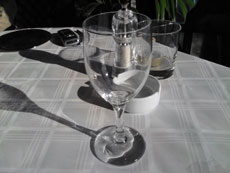 |
 |
(+)
увеличить, 2048x1536, JPEG |
(+)
увеличить, 2048x1536, JPEG |
Video. The device is capable of shooting video
clips in 3 different resolutions, these are 320х240, 176х144 and
128х96 pixels. All additional settings copy the corresponding ones
for camera mode Ц you can adjust special effects, exposure time,
white balance and viewfinderТs appearance. The developers havenТt
capped duration of clips Ц you can easily record video up to 1 hour
in length. All movies are saved in mped4 format, at that you can
check the option, related to sound recording. In course of shooting,
you can interrupt the process, pause it start over again.
You can apply zoom (x6) only before shooting Ц once youТve started
filming, youТll be not at liberty to adjust this parameter; itТs
seems strange and rather unhandy.
The video recording quality is above average Ц all the clips look
fine when watched on the handset and donТt possess any obvious flaws
in maximum resolution Ц further more, the quality remains fair even
on PC. I shall note that the clips, filmed with the help of this
handset are better than the ones, recorded with many other devices,
including Sony Ericsson K790/K800, which features a 3 Mpix camera
as well.
Sample
video 1 (ћ–4, 1.03 Mb)
Sample
video 2 (ћ–4, 1.00 Mb)
Sample
video 3 (ћ–4, 1.35 Mb)
Sample
video 4 (ћ–4, 1.34 Mb)
Sample
video 5 (ћ–4, 1.61 Mb)
While in camera mode, you can also choose several additional functions,
which are accessed from Settings menu Ц by pushing the accept key
while highlighting this item, you will call up a navi-circle. In
particular, there you can choose video recording mode and general
settings for images.
The imagesТ quality can be set to one of the following: SuperFine,
Fine, Normal, Economy.
- Metering Ц Multi, Center
- Single Shot Ц Automatic, Take and Save
- Shutter sound Ц On or Off
- Zooming sound Ц On or Off
- Brightness changing sound - On or Off
- Focusing sound - On or Off
- Storage place for images Ц memory card or internal memory



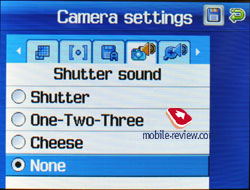




One of the most interesting features, incorporated into the handset
is viewing mode, when you pick a certain folder with pictures or
video clips and browse all the saved files, in slide-show or normal
mode.
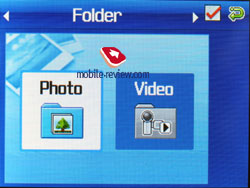
Everything we have left to do it to mention the last mode, going
by the name of NameCard. While using this one, the camera automatically
switches to Macro Mode and allows taking pictures of business cards
Ц itТs essential to keep the distance of 9-10 centimeters between
the objective glass and the item itself, in order to have the business
card in focus, youТll require soft illumination; therefore try to
step away from any table lamps. Having taken an image, youТll have
to wait 30-40 seconds while the device is processing all acquired
data, after this the information is directed straightly to the corresponding
fields in the phonebook, which can be edited or deleted later on.
The recognition quality is very average, as many symbols are not
processed correctly. ItТs important to understand, that a function
of this kind is provided only in smart handsets, where the recognition
function works very well, but of course CPU speeds are much greater
there, so the developers are free to use more complicated algorithms
of processing images. There is no way one could use this function
of Z710 in practice, though this very step toward incorporating
this option into standard phones makes all the difference.
Video clip,
demonstrating this function>>>
Short sum-up
There are not so many handsets on the market, which could boast
of a 3 Mpix camera, and against this background, Z710 appears to
be fairly good solution. The imagesТ quality here, as well as overall
capabilities, is higher than in products by Nokia, namely Nokia
N80 (we are talking here about the latest firmware various, which
will hit to shelves of retail stores). On the whole, the camera
canТt stand competition with Sony Ericsson K790/K800, as it outputs
pictures of worse quality, though on the other hand its main advantage
is video recording.
It appears, that we face the same situation, which is typical for
the market of 2 Mpix cameras: solutions by Samsung are comparable
with NokiaТs handsets in terms of cameraТs quality or even overcome
them a bit, but lose to the camera module, featured in Sony Ericsson
K750i.
The number of camera settings in Samsung Z710 is closing in to
digital cameras Ц in case the manufacturer takes a decision to increase
the quality of the matrix, optical system and keep the functionality
on the same level, it can result in several extremely attractive
solutions Ц and itТs not so long left until this moment, I assure
you.
Eldar Murtazin (eldar@mobile-review.com)
Oleg Kononosov (oleg.kononosov@mobile-review.com)
Published — 21 March 2006
Have something to add?! Write us... eldar@mobile-review.com
|
News:
[ 31-07 16:21 ]Sir Jony Ive: Apple Isn't In It For The Money
[ 31-07 13:34 ]Video: Nokia Designer Interviews
[ 31-07 13:10 ]RIM To Layoff 3,000 More Employees
[ 30-07 20:59 ]Video: iPhone 5 Housing Shown Off
[ 30-07 19:12 ]Android Fortunes Decline In U.S.
[ 25-07 16:18 ]Why Apple Is Suing Samsung?
[ 25-07 15:53 ]A Few Choice Quotes About Apple ... By Samsung
[ 23-07 20:25 ]Russian iOS Hacker Calls It A Day
[ 23-07 17:40 ]Video: It's Still Not Out, But Galaxy Note 10.1 Gets An Ad
[ 19-07 19:10 ]Another Loss For Nokia: $1 Billion Down In Q2
[ 19-07 17:22 ]British Judge Orders Apple To Run Ads Saying Samsung Did Not Copy Them
[ 19-07 16:57 ]iPhone 5 To Feature Nano-SIM Cards
[ 18-07 14:20 ]What The iPad Could Have Looked Like ...
[ 18-07 13:25 ]App Store Hack Is Still Going Strong Despite Apple's Best Efforts
[ 13-07 12:34 ]Infographic: The (Hypothetical) Sale Of RIM
[ 13-07 11:10 ]Video: iPhone Hacker Makes In-App Purchases Free
[ 12-07 19:50 ]iPhone 5 Images Leak Again
[ 12-07 17:51 ]Android Takes 50%+ Of U.S. And Europe
[ 11-07 16:02 ]Apple Involved In 60% Of Patent Suits
[ 11-07 13:14 ]Video: Kindle Fire Gets A Jelly Bean
Subscribe
|


















































































